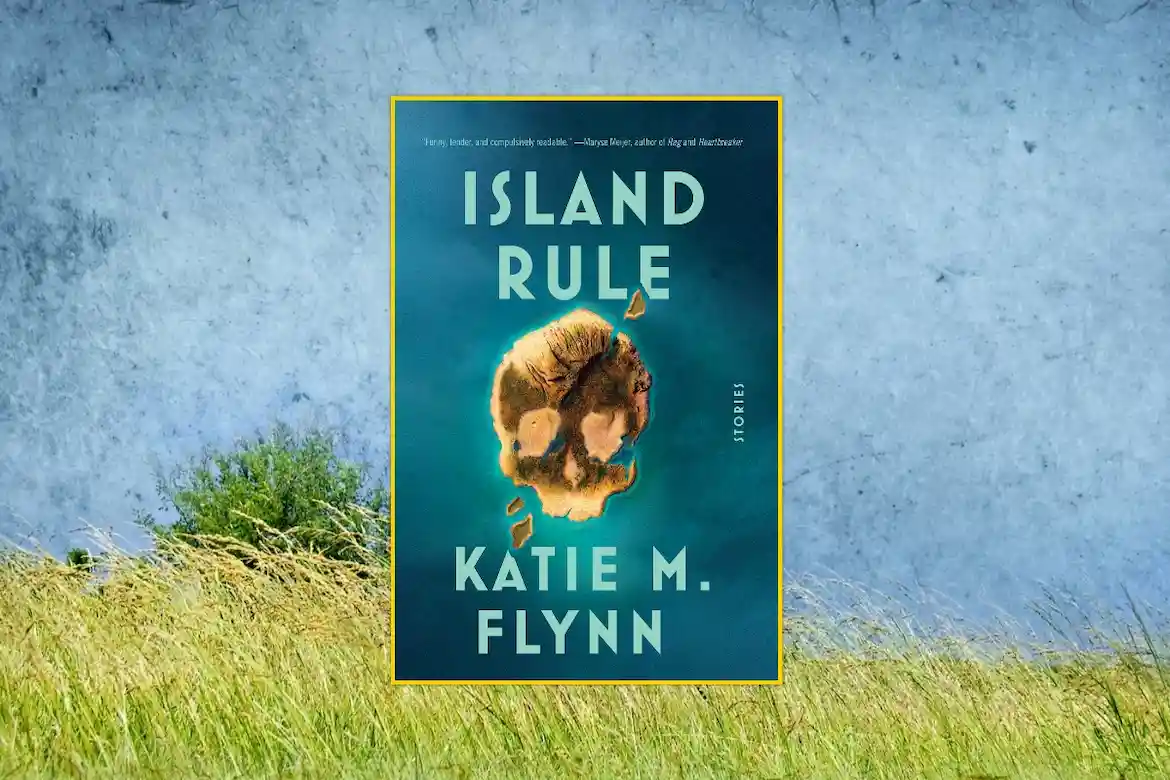In Island Rule, Katie M. Flynn’s characters are connected so deeply, so profoundly, and so variously, that they offer an entirely new view of what connection can mean.
In This LitStack Review of Island Rule
The Sperical World of Island Rule
Collections of linked stories and novels-in-stories offer the reader dual pleasures. There’s the pleasure of discrete and cohesive short stories, each its own world and shape, those compressed moments of time. And there’s also the pleasure that comes with longer narratives, as the stories accrue mosaically, where we see the effect of time on characters and the societies they move through.
Katie M. Flynn’s Island Rule is clearly a collection of linked stories, but it is such an original creation that I don’t yet have a name for it—a sphere of stories? Where most such collections focus on one or more characters as they progress through time, and usually in a single place, Flynn’s characters are connected so deeply, so profoundly, and so variously, that they offer an entirely new view of what connection can mean.
Monsters Go Missing
The individual stories in Island Rule are brilliant and fulfilling on their own, as well as a little frightening. Most of Flynn’s central characters are women, and these women are all on the verge of extraordinary transformations.
A San Francisco wife and mother slowly becomes a monster, gray and shriveled, then disappears without a trace. A 12 year old girl goes missing, creating panic in her neighborhood, even though she is hiding in the family mortuary’s display coffin, only to be resurrected. An older woman, on vacation with her husband in Oslo, is so often mistaken for a famous Swedish actress of the past that she first becomes that actress, then disappears without a trace. What drives all these transformations and disappearances is isolation; each of the women in Island Rule is cut off from the world around them by virtue of, it seems, simply being a woman in the world.
And around these women, the world itself is off kilter. Babies appear and disappear. Animals are infected by grotesque mutations. The International Space Station implodes on live TV. National Parks are run by for-profit prisons.
It’s a volatile world.


Spheres and Tunnels
In her diary, while writing Mrs. Dalloway, Virginia Woolf rebels against the “appalling narrative business of the realist.” Her novels, she writes, should be spheres, not time’s arrows, and on those spheres, the characters are to be connected, one to the other, by tunnels, deep and profound connections.
In Island Rule, the connections between characters are often random seeming, and inconsequential. Across the stories, and with no pattern, objects and gestures recur, felt by the reader but never insisted upon. In the first story, a child’s blue barrette is mentioned, then some stories later, with different characters and in a different place and time, a similar blue barrette appears, only to appear later still, then appearing again in the final story. The litany of these connections is long: a particular hamster, a mythical Pacific Island ruled by a speedo-wearing dictator, a 17th century Norwegian explorer’s teeth, a taco bar in San Diego, packets of oyster crackers, and, chillingly, unexplained piles of human bones.
The characters in Island Rule are connected in a unique manner. A minor character in one story may become the central character in another, only to appear as a whisper or distant relative in a third story. The connections are not by relation—that is to say, not by blood or marriage or friendship or work—but by happenstance and coincidence.
All throughout Island Rule, running like a dark current, are the facts of the world these characters, like ourselves, must navigate: climate change, rabid political divisions, the oppressive insistence of new technologies, poverty, reality TV, Dating Apps, etc.
To truly create a more spherical book, Flynn eschews linear time; the stories in Island Rule leap about the years, with no real markers for these jumps. The effect offers a kind of simultaneity, as if all these stories, separated by many years at times, are happening at once.
Islands and Archipelagos
Flynn’s world is one in which—true to the nature of the short story—characters are isolated from one another, each an island to themselves. But by connecting these characters through her various tunnels, Flynn has created a chain of islands, an archipelago, undeniably linked. And this is the book’s great revelation, that, despite the solitude the world insists on imposing, we are still connected, over time and place, even when those connections are frightening.
Connected, nonetheless, hilariously and tenderly. Island Rule offers no false hope, but neither does it romanticize disconnection. We are, Flynn insists, both lonely and connected, damn it.
In the final story of Island Rule, the sphere is complete. The narrator, Agatha, is the daughter of the woman-monster who disappeared in the first story some 30 years earlier. Agatha lives with “My Boyfriend,” who is a character with his own story early on and makes a few other appearances. There are a score of images from earlier in the book that arrive together in this story, the blue barrette, for instance, the Norwegian explorer’s teeth, a stuffed gray bunny, rodents in the walls, etc. Agatha and My Boyfriend are about to break up, but the ending is so tender, so natural, that it heals rather than divides. They sit together on a bench, swinging softly.
“’Sorry,’ I tell him as he closes his hand around the teeth, a type of good-bye, love being a thing that can’t stay the same, that can’t stay.”
~ Lewis Buzbee
About Katie M. Flynn
Katie M. Flynn is a writer, editor, and educator based in San Francisco. Her short fiction has appeared in the San Francisco Chronicle, Tin House, and Tor, among other publications. She has been awarded Colorado Review’s Nelligan Prize for Short Fiction, a fellowship from the San Francisco Writers Grotto, and the Steinbeck Fellowship in Creative Writing. Katie holds an MFA from the University of San Francisco and an MA in geography from UCLA. Her first novel, The Companions, was published in 2020.
You can connect with Katie M. Flynn on her website, and on Instagram.
Source: Publisher
Publisher: Simon & Schuster Gallery/Scout Press
ISBN13: 9781982122218
Pub Date: April 1, 2025
Titles by Katie M. Flynn and Others

Other LitStack Resources
Be sure and look at our other LitStack Reviews for our recommendations on books you should read, including reviews by Lewis Buzbee, Lauren Alwan, Allie Coker, Rylie Fong, and Sharon Browning.
Comment Using Emote
As a Bookshop, Malaprop’s, BAM, Barnes & Noble, Audiobooks.com, Amazon, and Envato affiliate, LitStack may earn a commission at no cost to you when you purchase products through our affiliate links.







